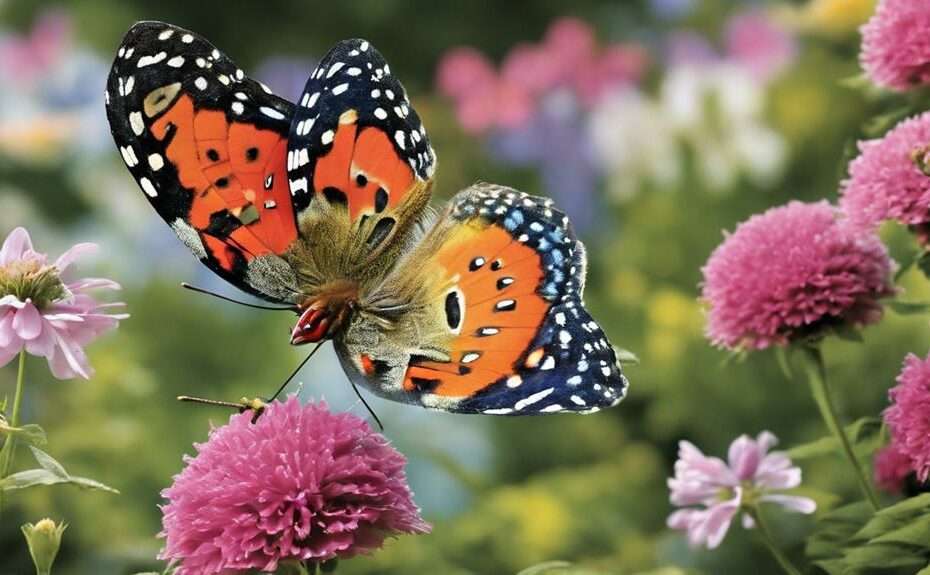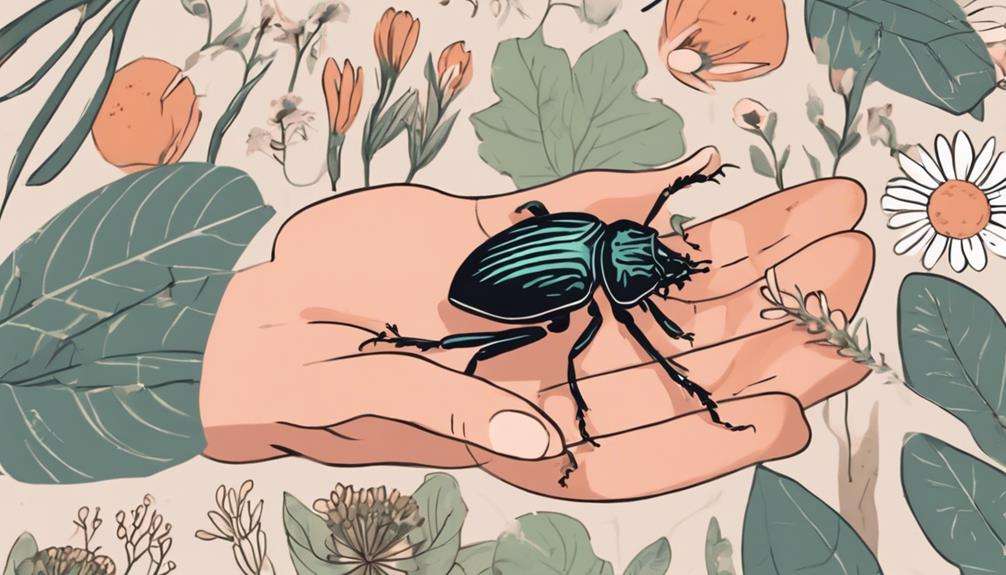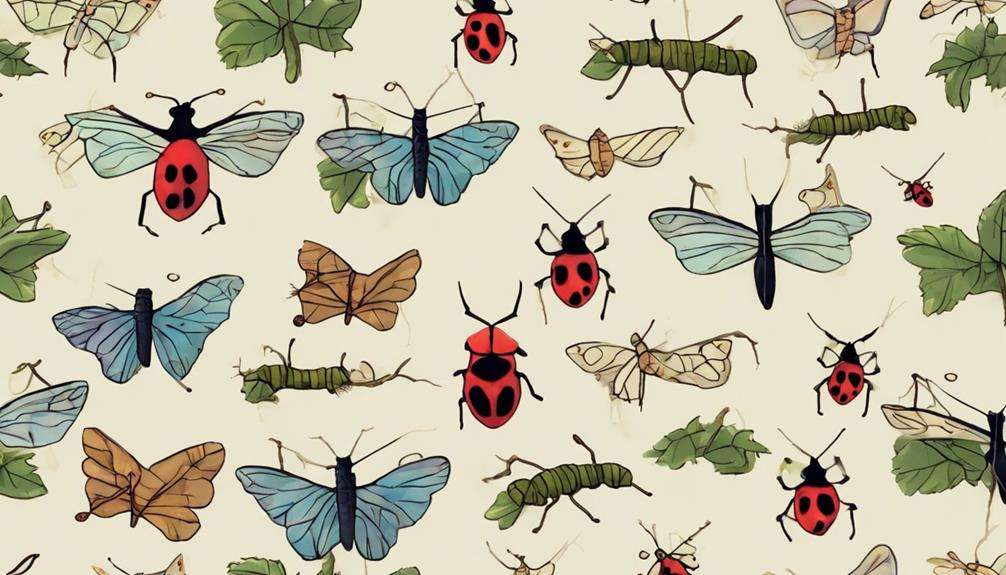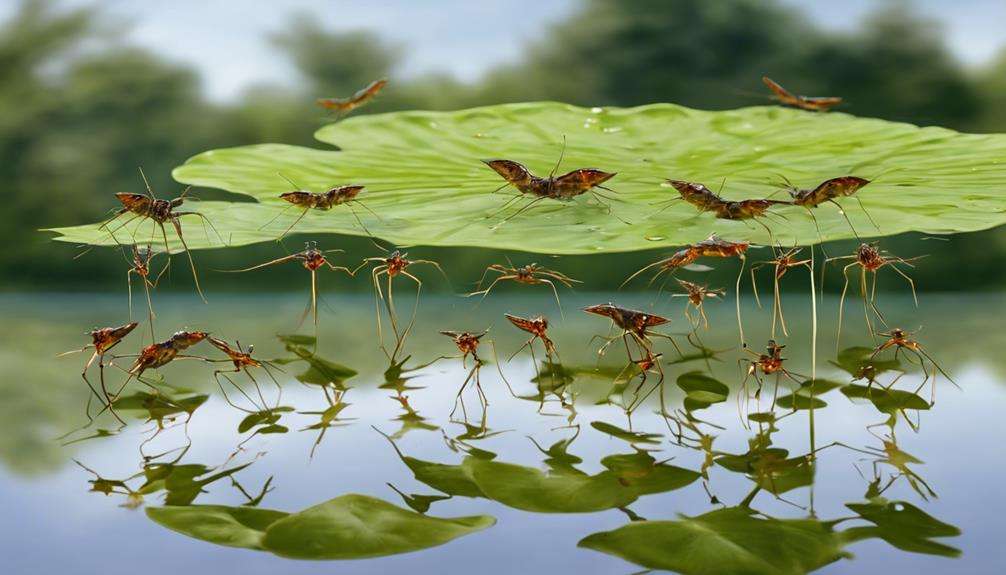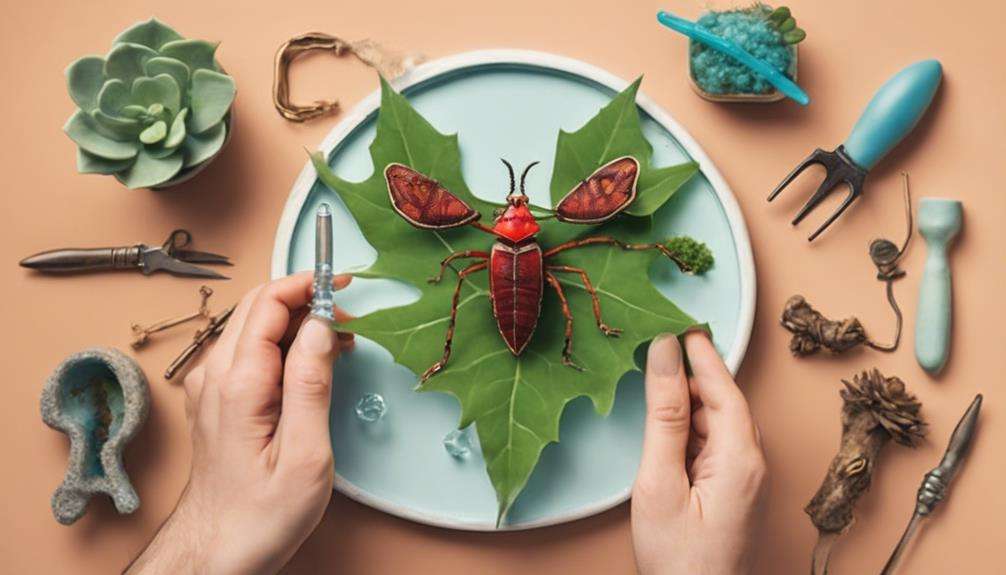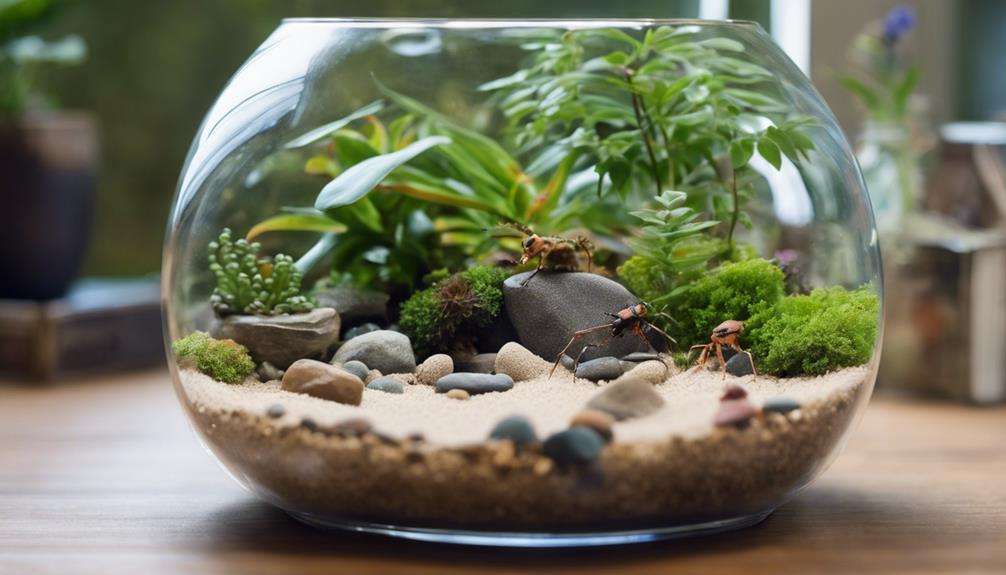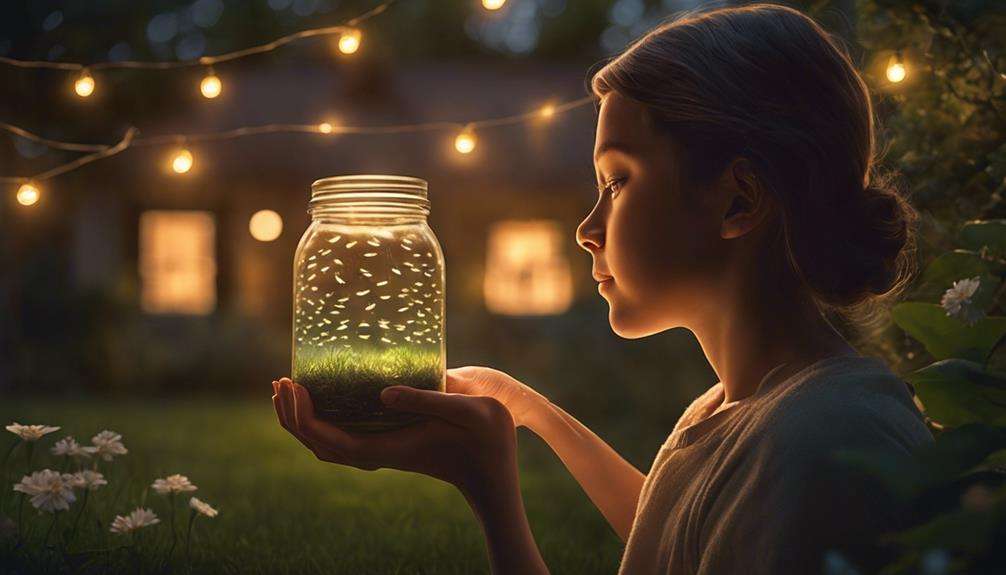If you're seeking to add a touch of delicate elegance to your world, exploring the domain of pet butterflies might just be the perfect fluttering journey for you.
As you consider the 10 best species for quaint enthusiasts, each one brings its own charm to the table. The subtle hues of the Painted Lady, the graceful flight of the Eastern Tiger Swallowtail, and the intricate patterns of the Zebra Longwing are just the beginning of the enchanting possibilities awaiting you.
So, why not take a closer look at these charming creatures and discover which one resonates most with your tranquil spirit?
Key Takeaways
- Butterfly species vary in size, color, and habitat preferences.
- Conservation efforts are crucial for protecting delicate species.
- Butterfly gardens enhance biodiversity and provide educational opportunities.
- Creating butterfly enclosures ensures safety, observation, and breeding success.
Painted Lady (Vanessa Cardui)
The Painted Lady butterfly, scientifically known as Vanessa cardui, is a globally distributed species found on every continent except Antarctica and South America. When it comes to proper care for these beautiful butterflies, there are a few key considerations to keep in mind.
First and foremost, it's essential to provide a suitable habitat for your Painted Lady butterflies. This includes a spacious enclosure with ample room for flying and perching. Additionally, the enclosure should have fresh flowers for nectar, as well as host plants like thistles and mallows for egg-laying and caterpillar development.
Maintaining the right temperature and humidity levels is critical for the well-being of your Painted Lady butterflies. Keeping the enclosure at a consistent temperature between 20-25°C and making sure there's proper ventilation will help mimic their natural habitat.
To conclude, a balanced diet is essential for the health of your Painted Lady butterflies. Providing them with a sugar solution or diluted honey for feeding, along with fresh fruits like oranges and watermelon, will help keep them nourished and thriving in captivity. Proper care ensures these fascinating butterflies can flourish in a controlled environment.
Cabbage White (Pieris Rapae)
With its distinctive white wings adorned with black markings resembling cabbage leaves, the Cabbage White butterfly, scientifically known as Pieris rapae, is a prevalent species found in various regions across Europe, Asia, and North America. These delicate insects thrive in environments with high humidity levels, making them well-suited for regions with moister climates. The Cabbage White butterfly typically has a wingspan ranging from 1.5 to 2 inches, showcasing its petite yet elegant appearance.
In their caterpillar stage, Cabbage White butterflies are often considered pests due to their feeding habits on crops like cabbage, broccoli, and other cruciferous vegetables. However, when cared for in captivity, these butterflies are easy to maintain and observe, making them an excellent choice for enthusiasts and beginners alike. Their adaptability to various conditions and relatively simple care requirements contribute to their popularity among butterfly enthusiasts. Observing the transformation of these butterflies from caterpillars to graceful flyers can be a rewarding experience for those interested in the world of butterflies.
Red Admiral (Vanessa Atalanta)
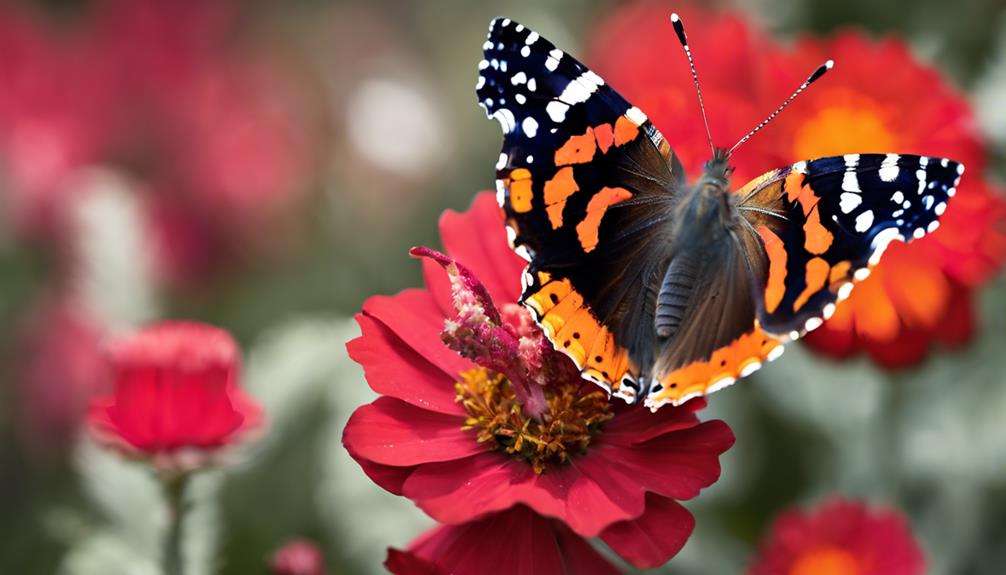
Admire the vibrant red-orange bands and significant white spots adorning the wings of the Red Admiral butterfly, scientifically known as Vanessa atalanta. This striking butterfly species can be found in various habitats across North America, including regions in North and Central America. Red Admirals are known for their strong migratory behavior, traveling long distances to seek suitable breeding grounds and food sources. They've a diverse diet, being attracted to rotting fruit, tree sap, and nectar from flowers such as milkweed, asters, and daisies.
In North America, the Red Admiral's caterpillars play an important role in the ecosystem by feeding on specific host plants like nettles. This creates a symbiotic relationship between the butterfly and these plants, highlighting the interconnectedness of species in their environment. Observing the Red Admiral in its natural habitat can offer enthusiasts a glimpse into the fascinating world of butterfly biology and behavior.
Eastern Tiger Swallowtail (Papilio Glaucus)
Eastern Tiger Swallowtail (Papilio Glaucus), a species known for its large size and striking yellow and black striped pattern, is commonly found in Eastern America. These butterflies exhibit a remarkable resemblance to tigers due to their vibrant yellow wings adorned with bold black stripes. Additionally, near their tails, you can spot exquisite blue and orange markings, adding to their overall beauty.
Adaptable to various environments, Eastern Tiger Swallowtails thrive in open woodlands, fields, and gardens. Their wingspan ranges from 3.5 to 6 inches, making them visually impressive and alluring creatures to observe in natural settings. The caterpillars of this species feed on a diverse range of host plants, including cherry, ash, and tulip trees, before undergoing a stunning transformation into the magnificent butterflies they're known to be. If you seek a visually striking butterfly species to admire and appreciate, the Eastern Tiger Swallowtail is an excellent choice for any butterfly enthusiast.
Monarch (Danaus Plexippus)
Monarch butterflies, scientifically known as Danaus Plexippus, are revered for their striking orange and black wing patterns.
These iconic butterflies undertake a remarkable migration journey from North America to Mexico, spanning thousands of miles.
It's imperative to understand their habitat preferences and engage in conservation efforts to protect these majestic creatures and their essential milkweed plant ecosystem.
Monarch Butterfly Facts
Belonging to the Nymphalidae family, Danaus plexippus, commonly known as the Monarch butterfly, is distinguished by its vibrant orange and black wings. Monarchs are renowned for their incredible annual migration from North America to Mexico, spanning thousands of miles.
These butterflies have a unique relationship with milkweed plants, as their caterpillars exclusively feed on them. Conservation efforts are important to safeguard Monarch populations against threats like habitat destruction, climate change, and pesticide use.
Monarchs symbolize beauty and resilience, fascinating enthusiasts and conservationists globally. Their striking appearance and remarkable behaviors make them a beloved species among butterfly admirers. Understanding and protecting the Monarch butterfly is essential for ensuring the preservation of this iconic insect for future generations.
Monarch Habitat Preferences
Having a strong preference for habitats abundant in milkweed plants, the Monarch butterfly (Danaus plexippus) strategically selects locations for egg-laying and larval development. These butterflies rely on milkweed as the sole food source for their larvae, as it contains toxins that make them and their caterpillars unpalatable to predators. Monarch butterflies are commonly found in open fields, meadows, and gardens where milkweed grows profusely.
This plant serves as a critical component of their life cycle, with female Monarchs carefully choosing milkweed leaves to deposit their eggs. Understanding and conserving these milkweed-rich habitats is essential for ensuring the survival of Monarch populations, as they play a crucial role in the butterfly's reproductive success and overall health.
Monarch Conservation Efforts
Conservation efforts for the Monarch butterfly species (Danaus plexippus) involve implementing strategies to support their populations in the face of habitat loss and climate change challenges.
Monarchs, known for their remarkable migration from North America to Mexico, are facing declining numbers. Planting milkweed, the essential host plant for monarchs, plays a critical role in monarch conservation efforts by providing a necessary breeding ground.
Conservation organizations actively track monarch populations to gauge the effectiveness of these initiatives. Protecting monarch butterflies isn't only important for their survival but also for the ecosystems they support as key pollinators.
Blue Morpho (Morpho Peleides)
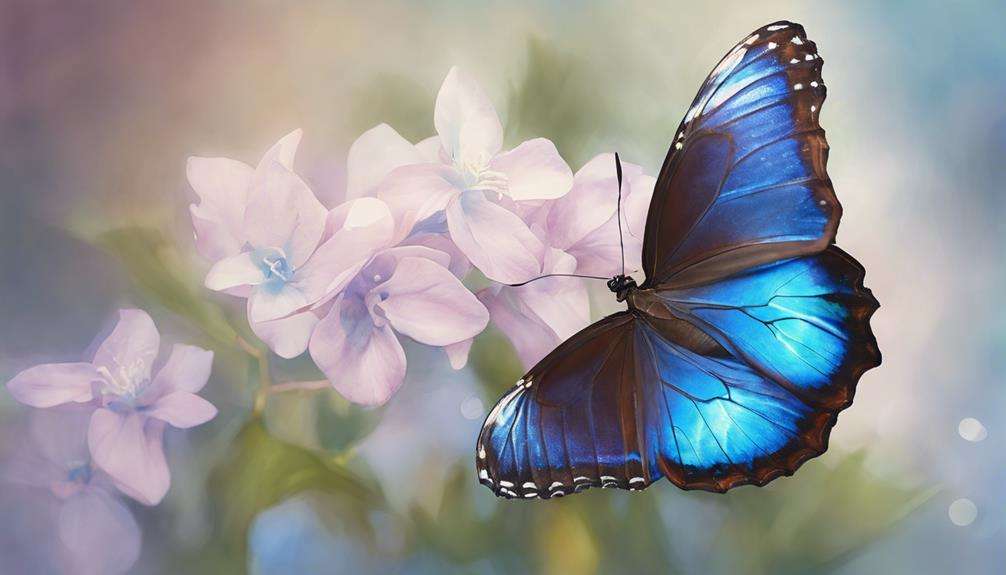
The Blue Morpho (Morpho Peleides) is an alluring butterfly species coveted for its mesmerizing iridescent blue wings that dazzle under varying light conditions.
Originating from Central and South America, these butterflies thrive in lush rainforest habitats, requiring ample space and access to rotting fruits for sustenance.
To care for Blue Morphos in captivity, make a humid environment, provide fresh fruits for feeding, and create a spacious enclosure that mimics their natural rainforest habitat.
Blue Morpho Appearance
With their iridescent blue coloration created by microscopic scales that reflect light, the Blue Morpho butterfly (Morpho peleides) captivates enthusiasts with its striking appearance. This vivid blue hue, seen mainly on the upper side of their wings, isn't a result of pigmentation but rather the intricate structure of their wing scales.
These butterflies, native to Central and South America, particularly thrive in the lush rainforests of countries like Mexico, Venezuela, and Brazil. Sporting an impressive wingspan of around 5-6 inches, the Blue Morpho is among the largest butterfly species globally, adding to its allure.
Their beauty and graceful flight make them popular attractions in butterfly exhibits, where their mesmerizing appearance never fails to leave a lasting impression on observers.
Butterfly Habitat Needs
In order for Blue Morpho butterflies (Morpho peleides) to thrive, they require specific tropical habitats with high humidity levels. These butterflies are highly sensitive to changes in humidity, needing levels above 70% to maintain their health and vibrant appearance. In their natural environment of Central and South America, Blue Morphos inhabit rainforests where the humidity remains consistently high.
Mimicking this environment in captivity is essential for their well-being. To achieve the necessary humidity levels, you can use a misting system or humidifier in their enclosure. Ensuring the humidity is within the ideal range will help the Blue Morpho butterflies exhibit their characteristic iridescent blue wings and lead to a healthier and happier pet butterfly experience.
Pet Care Tips
For excellent care of your Blue Morpho butterfly (Morpho Peleides), make sure their enclosure offers ample space for flight and includes appropriate dietary plants like bananas and citrus. Blue Morpho butterflies thrive in environments with high humidity levels, ideally around 70-80%, mimicking their natural tropical habitat.
Maintain a consistent temperature between 75-85°F to keep your butterfly healthy and active. Providing fresh fruit or nectar feeders can supplement their diet and ensure they receive essential nutrients. Regularly misting the enclosure with water helps maintain the necessary humidity levels.
Remember to clean the enclosure frequently to prevent mold growth and maintain a hygienic environment for your Blue Morpho butterfly. Following these care tips will help your butterfly flourish in captivity.
Glasswing (Greta Oto)
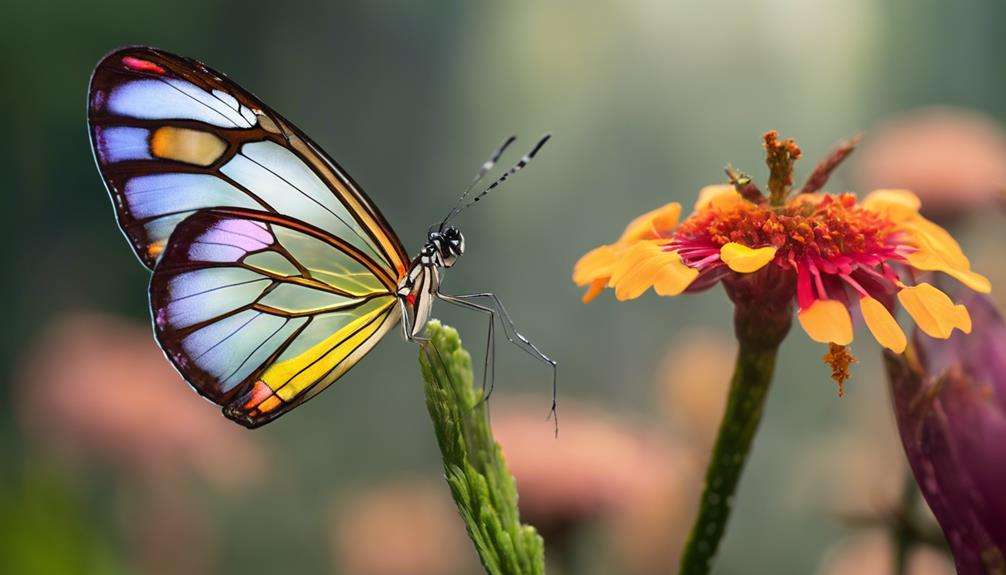
Glasswing butterflies, known scientifically as Greta Oto, exhibit a remarkable delicacy and ethereal beauty with their transparent wings. These beautiful butterflies are native to Central and South America, inhabiting regions from Mexico to Panama. Their unique transparent wings give them a mystical appearance, making them an enchanting choice for butterfly enthusiasts.
Glasswings primarily feed on flower nectar, being attracted to a variety of flowering plants in their natural habitat. With a wingspan ranging from about 2.2 to 2.4 inches (5.6 to 6.1 cm), these butterflies belong to the brush-footed butterfly family, known for their distinctive characteristics.
The Glasswing butterfly's graceful presence and striking aesthetic make them a delightful addition to any butterfly enthusiast's collection. Observing these creatures flutter among flowers with their almost magical transparency is a truly enchanting experience that can bring joy and wonder to those who appreciate the beauty of nature.
Zebra Longwing (Heliconius Charithonia)
With its distinctive black and white striped wings, the Zebra Longwing butterfly, scientifically known as Heliconius Charithonia, captures attention as a striking species native to Central and South America.
These butterflies have a wide range, inhabiting regions with tropical and subtropical climates, showcasing their adaptability to diverse environments.
Zebra Longwings are renowned for their social behavior, forming communal roosts at night, offering an intriguing spectacle for observers.
One fascinating aspect of these butterflies is their extended lifespan of several months, making them ideal for individuals seeking long-term companionship in a pet butterfly.
Their diet mainly consists of nectar and pollen, simplifying their care requirements in captivity.
The Zebra Longwing's striking appearance, coupled with its social tendencies and longevity, makes it a captivating choice for butterfly enthusiasts looking to admire and interact with these beautiful creatures.
Julia Butterfly (Dryas Iulia)
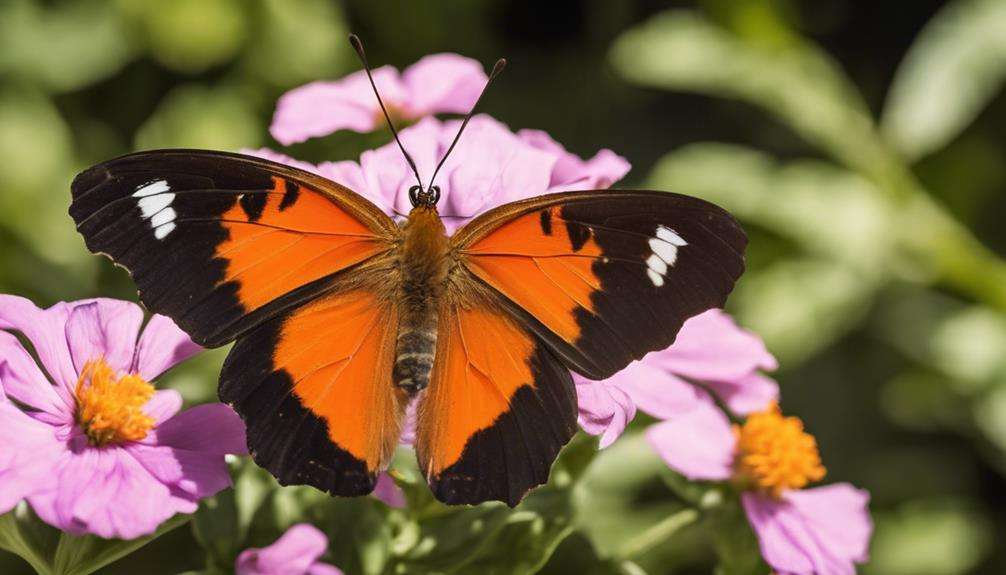
The Julia Butterfly, also known by its scientific name Dryas iulia, captivates enthusiasts with its vibrant orange wings adorned with black and iridescent blue markings. Originating from Central and South America, countries like Brazil, Mexico, and Paraguay serve as common habitats for this striking species.
Their preference for tropical and subtropical environments, along with a wingspan of 2.5 to 3 inches, contributes to the Julia Butterfly's allure in the world of butterfly enthusiasts.
Top Characteristics of Julia Butterfly
Characterized by vibrant orange wings adorned with striking black markings, the Julia Butterfly (Dryas iulia) is a species native to the warm climates of Central and South America. Their wings also feature patches of bright yellow, adding to their visual appeal.
These butterflies are attracted to bright colors in their surroundings and are often spotted in open areas like meadows, gardens, and forest edges. Julia Butterflies exhibit graceful flight patterns as they flutter from flower to flower, with a preference for nectar-rich blooms such as Lantana and Pentas.
With proper care, these enchanting butterflies can live for several weeks in the wild and even longer in captivity, making them a delightful choice for butterfly enthusiasts.
Habitat and Behavior Insights
Pivoting from the vibrant appearance of the Julia Butterfly, its habitat and behavior reveal insights into its natural tendencies and interactions within its environment.
Julia Butterflies, also known as Dryas Iulia, are native to Central and South America, commonly found from Mexico to Peru. They thrive in tropical and subtropical environments, favoring habitats like rainforests and tropical gardens.
Being diurnal creatures, they exhibit peak activity during daylight hours and rest at night. Male Julia Butterflies are conspicuously territorial, often seen patrolling specific areas to attract potential mates. This behavior showcases their unique social interactions within their ecosystem, contributing to the species' survival and reproduction in the wild.
Tree Nymph (Idea Leuconoe)
With its translucent white wings adorned with intricate black veins, the Tree Nymph butterfly, scientifically named Idea Leuconoe, enthralls enthusiasts with its striking beauty and grace.
While native to Southeast Asia, this mesmerizing species can also be found in regions like Indonesia, Taiwan, and the Philippines. The Tree Nymph butterfly thrives in tropical environments, making it an excellent choice for pet owners residing in warm climates.
Known for their elegant flight patterns, these butterflies are often spotted nectaring on flowers such as lantana and pentas. Symbolizing beauty and grace, the Tree Nymph butterfly can create an enthralling presence in butterfly gardens or enclosures for pet enthusiasts.
Whether you're admiring their delicate appearance or observing their graceful movements, the Idea Leuconoe species is sure to enchant you with its charm and allure. Consider welcoming this enchanting butterfly into your home and experience the wonder it brings to your surroundings.
Frequently Asked Questions
What Is the Friendliest Butterfly Species?
When it comes to butterfly behavior, the Painted Lady stands out as the friendliest species. Their docile nature, social interactions, and adaptability to various environments make them a delightful choice for pet enthusiasts seeking a charming companion.
What Is the Best Butterfly to Keep as a Pet?
When considering butterfly care, selecting a species that suits your preferences and abilities is crucial. Start by researching care requirements, availability, and personal interests. This will help you choose the best pet butterfly for a fulfilling experience.
What Is the Easiest Butterfly to Keep?
When it comes to butterfly care, the Painted Lady butterfly shines as the easiest to keep. With their adaptability, diverse diet, and resilience, they make a great choice for beginners. Their caterpillars are a joy to observe as they grow.
What Is the Most Liked Butterfly?
You love butterflies and wonder about the most liked species. Monarchs are adored worldwide for their beauty and symbolic meaning. Butterfly conservation efforts focus on protecting these treasured insects, ensuring their survival for future generations to enjoy.
Conclusion
Congratulations on choosing to commence on the fascinating journey of keeping pet butterflies!
With the exquisite Painted Lady, delicate Cabbage White, majestic Red Admiral, and stunning Eastern Tiger Swallowtail, your butterfly collection will be a sight to behold.
Remember, providing a safe and spacious environment for your fluttering friends is key to their well-being.
Get ready to witness the mesmerizing transformation and beauty of these magnificent creatures up close!
